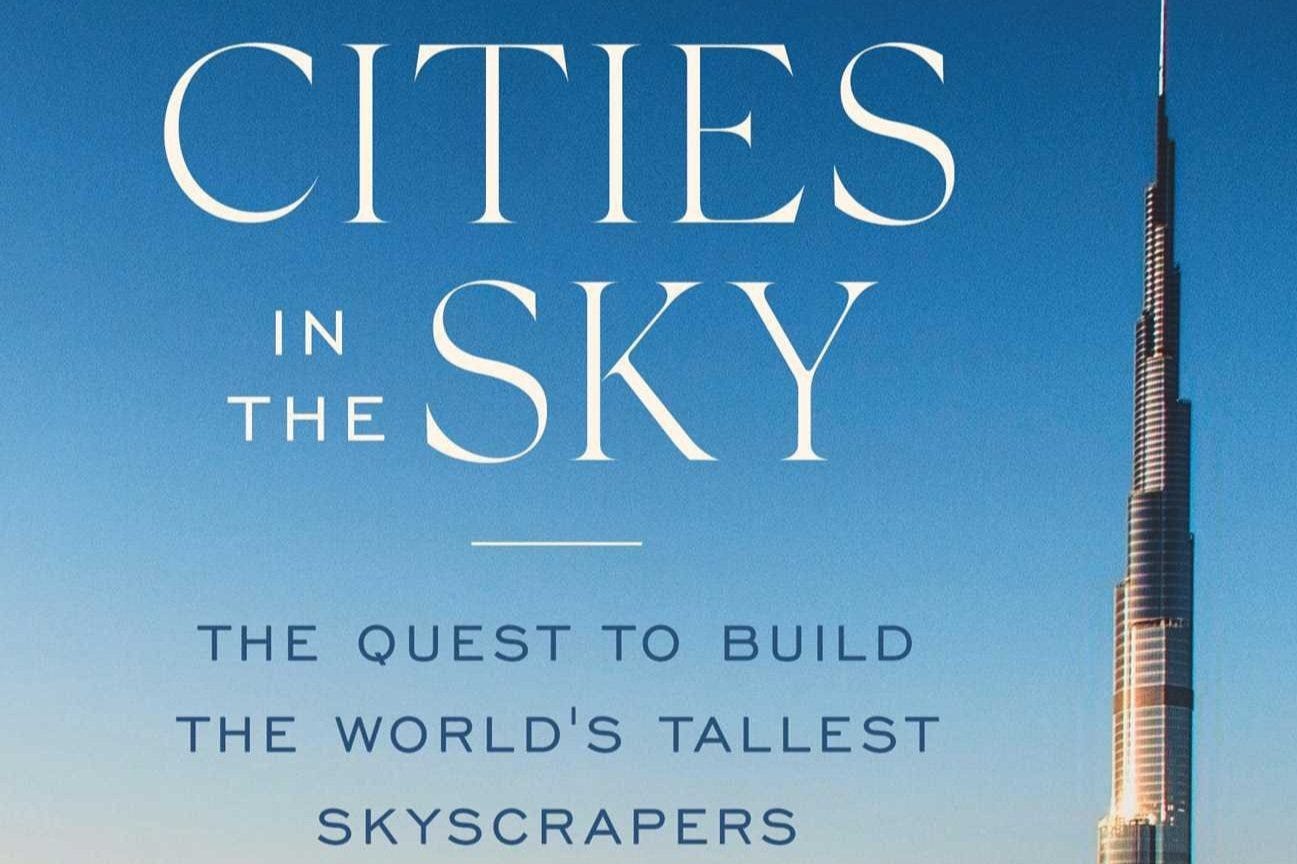The image of the skyscraper is the hallmark of the modern city. Futuristic depictions of urban landscapes nearly always feature towering structures high above the clouds. Today, however, developing countries seem to be putting the greatest effort into building the most impressive skyscrapers, from the Burj Khalifa in the UAE, to the future Jeddah Tower in Saudi Arabia. Whether you love them or hate them, it’s worth asking why we build skyscrapers and what their role will be in future cities. Today on Faster, Please! — The Podcast, I sit down with Jason Barr, author of Cities in the Sky: The Quest to Build the World’s Tallest Skyscrapers.
Barr is a professor of economics at Rutgers University – Newark, and is a member of the Rutgers Global Urban Systems PhD program. He is also the author of Building the Skyline: The Birth and Growth of Manhattan’s Skyscrapers.
In This Episode
Demand for the skyscraper (1:35)
The end of the skyscraper (9:00)
Pillars of commerce (14:05)
The sky’s the limit (18:36)
Manhattan extension (23:04)
Trends and styles (24:23)
Below is a lightly edited transcript of our conversation
The image of the skyscraper is the hallmark of the modern city. Futuristic depictions of urban landscapes nearly always feature towering structures high above the clouds. Today, however, developing countries seem to be putting the greatest effort into building the most impressive skyscrapers, from the Burj Khalifa in the UAE, to the future Jeddah Tower in Saudi Arabia. Whether you love them or hate them, it’s worth asking why we build skyscrapers and what their role will be in future cities. Today on Faster, Please! — The Podcast, I sit down with Jason Barr, author of Cities in the Sky: The Quest to Build the World’s Tallest Skyscrapers.
Barr is a professor of economics at Rutgers University – Newark, and is a member of the Rutgers Global Urban Systems PhD program. He is also the author of Building the Skyline: The Birth and Growth of Manhattan’s Skyscrapers.
Demand for the skyscraper (1:35)
Pethokoukis: You obviously love skyscrapers, you're fascinated by them. You wrote a whole book on them. So I want to just start the very basic question: Why do skyscrapers fascinate you, and the people who aren't fascinated by them, what are they missing?
Barr: Great questions. Well, I grew up on Long Island, and so I was always really fascinated with Manhattan. I grew up in the ’70s, and so New York back then was a very dark, mysterious place for a youngster. So when I grew up, actually when I was in college, I started hanging out in the city. So to me, the skyline of Manhattan and New York City, they're just two sides of the same coin. I really developed an interest in tall buildings through my interest and fascination with Manhattan’s and New York City's history.
So when I came to Rutgers Newark, I just started doing research on tall buildings, especially in New York City: what was driving the heights of these buildings; there's all these interesting height cycles over the last 150 years. So I wrote my first book on the Manhattan skyline, that was called Building the Skyline, and then after that I thought, let's see what's happening around the rest of the world. So to me, the tall building is an interesting thing because it's part and parcel with urbanization, and I just personally don't think you could have one without the other.
I think some people might think that skyscrapers are, at least for rich countries, that they're kind of a 20th-century thing that we did as we were growing, and cities were getting bigger, and skyscrapers are a part of that, but now they're for other parts of the world, parts of the world which are still urbanizing, which are still getting richer. Are skyscrapers are still a thing for America?
The short answer is yes, but, given how dense cities are, tall buildings are just being added a lot more slowly. In New York, the population's kind of slowly growing, and so tall buildings are either replacing old buildings that are wearing out, or there's always this push by big global corporations to be in the newest and latest tall building. And obviously there's this international demand from people abroad to have an apartment — or national demand — global demand to have some kind of residential presence in New York. But the thing is, people in other countries: cities, planners, residents in other countries, they look to New York, they look to Chicago, and I think, for many of them, they see New York as something they want to emulate, and New York is, on just about almost any metric, it's probably the top global city. And so I think cities today, especially in China, and Asia more broadly, they're trying to kind of replicate that, what you might call “the Manhattan magic,” and I don't really think people in this country realize how much tall building construction is going on in other cities around the world. People in this country are a little bit more cynical about the role of the tall building in urban growth and in housing affordability and stuff like this, but other cities are basically going gangbusters, is a way to put it.
Is that driven by fundamental economic forces? Is it kind of a “national greatness” kinds of signaling projects? Are there fundamental reasons, not just to build skyscrapers, but to build very, very tall skyscrapers?
“All of the above” is the answer. Fundamentally, if there's many, many people who want to be working, living, playing in the center, the only way to accommodate the demand to be in the center is to make more land in the center, so the skyscraper, at its heart, is what I would say is “land in the sky.” You just go vertical because there's constraints on how much land there is in the center.
Having said that, definitely the skyscraper is seen as a kind of way to advertise, a way to increase confidence in the place, and so you boost foreign direct investment. Observatories are huge money makers, there’s a big tourism component. A lot of critics will say, “Oh, it's all about spectacle and ego.” But really, for the book, and just more broadly my research, when you drill down on the economics of these super tall buildings, not all of them are profitable or profit-maximizing, but they all have a strong economic rationale.
Now, I just also want to say, China has its own thing going on, which sort of compounds the skyscraper construction-building there because of their unique governance structure and land ownership structure, but China is building tall buildings because, at the end of the day, there's a kind of, what I call, a “tall building bling.” There's just something that says, “This city is growing, this city is drawing population.” So we build a tall building and we boost confidence in the city. And it works, really.
The pictures don't have to be too old, if you look at a picture of Shanghai, it looks a lot different not too long ago. It's almost as if a whole other city just kind of fell from the sky, a city of skyscrapers, and where there were once goats or something grazing, there's now a bunch of massive skyscrapers.
Yeah, absolutely, and there's a few reasons for this. One is, I think Chinese residents more broadly see tall building as a natural way to live. I've talked to many Chinese residents, whether it's Shanghai or other cities, and to them, to own an apartment in the sky is like the greatest thing. It's their equivalent of the single family home in the United States. Living in the clouds is something many people aspire to. The other aspect of it is, Shanghai, and the Pudong neighborhood in Shanghai, was chosen basically to become a financial hub. Basically, the leaders were looking at Hong Kong and they thought it was a, to quote, I forgot the author, but to quote him in the book, the Shanghai officials and the National Party officials saw Hong Kong as that frustratingly free city, and so they wanted to create a kind of a financial hub in Shanghai. And so the Shanghai Tower, for example, is part of that plan to really draw people's attention to Shanghai, itself. So it was part of a master plan.
The end of the skyscraper (9:00)
I certainly remember that, after 9/11, I heard about “the end of the skyscraper,” and then during the pandemic, I heard about “the end of the city.” Now I'm guessing that cities will continue to exist and we're going to continue to build tall buildings.
Absolutely. What 9/11 did was just make sure that we make our building safer with fire protection measures. In many Asian countries, every 20 floors, let's say, are mechanical floors, so you have the electric equipment, and the heating, and the cooling, and water tanks. They can also surround these in concrete, and so if something's on fire, if a floor is on fire, they can go to this hermetically sealed floor, a refuge floor, and stay there and be protected. And the elevator cores, they're made of concrete, and so you wouldn't have something like what happened on 9/11. So it didn't really impact the demand; 9/11 didn't impact the demand for the tall building, it just made us make tall buildings safer. And of course the downside is if you want to go into an office building, you have to have a swipe and you have to have an entry, so the negative of 9/11 was more about heightened security and increasing protections in a way that engenders a little bit more mistrust of us. But the demand didn't go away.
Same thing with Covid. For big cities like New York and San Francisco, I'm sure the empty-office problem is going to dissipate. It'll take a while. This may be an overly broad statement, but the truth is, our present and future is in cities. The funny thing about the internet and social media and all that, it was supposed to allow us to suburbanize more, or run away from these big, overcrowded cities, but the truth is, social media and internet technology has just made cities even more important. So, as long as cities are growing, there'll be a demand for tall buildings
Of the tallest, I don't know, half-dozen buildings, have you been to all of them?
That's a good question. I've been to the Shanghai Tower, which was the second-tallest building in the world, now is the third-tallest. The one that replaced it, I think it's [Merdeka 118] in Kuala Lumpur, I believe. I didn't go to that one yet because that just opened up recently. I've been to the Burj Khalifa, which is the world's tallest building. I'd have to look at the list. I've been to the Sears Tower, Empire State Building . . . Anyway, so I've been to a handful of them. I can't say I've been to every single one of the super-tall buildings in the world
And in any of those super-tall buildings, can you open a window? Why can't you open the windows in these skyscrapers?
Well, the wind forces are just tremendous! The biggest problem engineering tall buildings is making sure that the building doesn't sway so that people feel it. The really fascinating thing about engineering tall buildings is this question: How do you allow the building to sway enough so that you don't have to — you don’t want to over-engineer a building so that you make it perfectly stiff because that's just completely uneconomic to do that, but you want to make sure the building sways just enough so if you're sitting there reading a newspaper or drinking a cup of coffee on the top floor, you don't feel it. And so the wind forces high, a thousand feet in the air, are just so tremendous. I think if you open the window, everything would just would just blow away.
I was thinking about some of those very, super-skinny residential buildings, which I guess seem to be becoming more popular, and do those people really feel the motion?
From what I can tell, the short answer is no. There's one lawsuit in Manhattan, in particular, where the engineering wasn't exactly perfectly right, but I think that represents the exception that proves the rule. The building is safe, that's not the problem, it's just that, when you're dealing with these super-skinny buildings — these are kind of a new kind of breed of super-tall buildings, so sometimes the engineering isn't perfectly right, so they will figure out ways to kind of fix those problems. The problems are solvable, but sometimes if you don't get it 100 percent right, people complain, and obviously there's lawsuits and you have to go back in and tweak the engineering. But these things are selling for 70, 80, 100 million dollars for a penthouse on the 90th floor, so people still value them, and if motion sickness was a problem, they'd be worthless.
Pillars of commerce (14:05)
In the book, you run through a number of myths: tall buildings being only for the rich, that they drive up housing prices in cities, again, that you mentioned a little bit earlier, that they're somehow bad economic deals. All these myths all tend to be very negative.
I'm not going to rename your book, but I could call it “Cathedrals in the Sky,” I mean, I think these are beautiful buildings that say a lot about human aspiration and to create a sense of awe. Boy, but some people just do not see it that way.
I think there's a few strands; I've been thinking about this. There's a kind of a NIMBY strand, and sort of a NIMBY/gentrification strand. So people in the middle income, let's say, they see their housing prices going up, their rent going up, and then they see these billionaire condos, and so they, in my opinion, or based on my research, there's a confusion of correlation and causation. So the most visible manifestation in people's minds of gentrification and affordability problems are the super-slim buildings, but New York City has something like 3.6 million housing units, and if you look at the outlying areas of Queens and Staten Island, they're just covered in one- and two-family homes. Those neighborhoods have added barely any housing. So all of the housing — I'm exaggerating here when I say the word “all,” but the vast majority of new housing units happens in the center where either the zoning is more permissive, or old industrial sites come online and things like this, so people don't realize that the problem of housing affordability is citywide, it just looks naturally to be in their neighborhood where high rises are going up.
Then there's another strand, which I would say is kind of the “Jane Jacobs strand” / the anti-public-housing strand. Jane Jacobs has some great points in her book, The Death and Life of Great American Cities about walkability, about eyes on the street. She wasn't a big fan of tall buildings, and this has kind of given rise to this whole movement of “human scale,” where five-story Greenwich Village buildings, or 10-story Parisian mansard-roof-type buildings are perfect, and any other deviation from that is somehow destroying the city. So there's that part of it, that people see tall buildings as somehow destroying the feel or the perfect fabric of the city. And lastly, obviously, some of the failures with the public housing policy has made people convinced that it's unhealthy to live in these tall buildings. I think that gets at what you're inquiring about. I think there's those different strains.
I wonder if part of it stems for a confusion about what are cities for, and I mean cities are, for a large part, are where people to come together for jobs and to conduct commerce. And if you think of them that way, then certain things make sense; but if you think of them as, I don't know, some sort of urban retreat, where it's kind of like a garden or . . . I don't know, but it's a very different view, and perhaps it is not just about bike paths, but it's about what facilitates people to connect.
Without jobs, without a labor market, there's no purpose to have a city. Maybe in the 18th or 19th century, you can create a city for the king or the empire, as are many examples, or the Vatican or something like this; so you can have these sort of political capital cities, or even Washington DC, but, fundamentally, 99 percent of the world’s cities are places where people go to work, and so, if you don't allow the labor market to function properly, which means having a functioning housing market, then all these ideas about “the good city” and “the perfectly crafted city,” they kind of are irrelevant.
So you have to start with: what makes a city grow, what makes people productive, and then how do we accommodate that? To the extent that we can improve design, all the better. There's always a million ways to make things better for people design-wise. I think bike lanes are great, and I think pedestrian-friendly cities are better than car-centric cities, but you can't start with designing the city first and then seeing what happens. You have to start with “let's make an attractive place to live and work” first, and then work on the design feature second.
The sky’s the limit (18:36)
How tall are these buildings going to get?
Okay, well, the next world's tallest building is going to be one kilometer: The Jeddah Tower, which had started, I think back in 2013 or 2015, had been stalled, there was some sort of political turmoil in Saudi Arabia, and they've just restarted this Jeddah Tower in the city of Jeddah. And so when that's completed, that's going to be one kilometer. There were some plans floated to have a two-kilometer building in Riyadh. I don't think anyone really thinks that's going to happen.
How long does it take to get up to your office in a two-kilometer building?
Well, that's the thing. They're coming up with new ways to get people up there faster. The old conventional steel cables could maybe go 500 meters or something like that, which is maybe 80 floors or something. Maybe if you had a really good cable, you can get people to 80 floors and then they'd have to switch. Now they have these composite . . . it’s KONE UltraRope, which could go 1000 meters, which could go basically one kilometer continuously. So if you can get people from the ground floor to wherever their destination is within a minute, that's kind of like the golden rule here. People are not willing to wait more than a minute once they get in the elevator. The trick really is the ear pressure, and that's probably the hardest part because you're going up so quickly, the air pressure changes, so you have to figure out ways to make sure the cabin remains pressurized, and then there's the air pressure up on the highest floors. So that, I would argue, is the fundamental issue that's going to be coming next on the horizon is how to efficiently pressurize the highest floors. Let's say you're a mile high; if you're a mile high on the top floor, that's the equivalent of going from New York to Denver in a minute, or two minutes. So you have to figure out a way how to pressurize the entire building so it has a constant air pressure.
If I were to look at the skyline of major American cities 50 years from now, would you expect them to be radically different, futuristic looking, maybe not two-kilometer buildings, but a lot of very, very tall buildings? Or is it again, if they're not growing, if population isn't growing, then that won’t happen?
People are always asking me what I think about the doom loops and all that. Pick New York as one end of the spectrum: It's always going to be adding new buildings, that's just in its DNA, and so you're going to have this kind of collage of different building styles. But other cities, smaller cities, maybe where people are moving now because working from home, they'll add a few tall buildings here, they'll have mini-skylines. Then the other cities, like a St. Louis, that's just going to have to kind of figure out a plan for growth. So I don't see the world as a kind of Jetsons-type world.
I mean, you never know what's going to happen with the technology. There’s one company, TK or Thyssenkrupp elevators, they're working on Maglev elevators, and this can actually be a game changer because you have these shafts, so the Maglev elevator cars, they can go up or down or they can go horizontal. Part of the goal with that is that everybody has their own — if it's an apartment building, they have their own elevator car, it takes them up to their apartment, it becomes the door. So that could be a real game changer . . . And then you could run these things horizontally. So if you have these Maglev elevators, you can not only run them horizontally within the building, but, in principle, if you could work out property rights or whatever, you could connect these things across buildings. But at the end of the day, it's really about preferences and a kind of cultural perception of the tall building, and I just don't see us in the United States us having a dramatic, country-wide rethinking of where we live. There's always going to be this desire for the single-family home in the suburbs. Now maybe that'll diminish to some degree, but as long as people see their own little house as their own little castle . . .
Unlike China, where there seems to be a great desire to live in these kinds of buildings.
Manhattan extension (23:04)
Have you had any takers about your proposal to make Manhattan bigger?
No.
You would extend it by about 2000 acres and maybe build some tall buildings on that, I don't know.
The idea would be to create a new mini-Manhattan extending Manhattan into New York Harbor. Just briefly, the idea was both to add more housing and add more land, and to protect lower Manhattan against sea level rises and so forth. I proposed this in a New York Times op-ed piece, and, naturally, I would say the majority of commenters and people had this sort of kneejerk reaction against it.
I had a kneejerk reaction for it! I loved it!
You are part of a small, select core of appreciators, let's say. Having said that, in the 21st century it’s just not something I think most people are willing to wrap their heads around. So
To me, that's an idea with the future, and I think you should not be dejected that it was not initially well-received. I think that kind of idea might actually have some legs.
Trends and styles (24:23)
Finally, let me ask you, whether it's because of computers or new materials, would we expect skyscrapers in the future to look any differently? I think some people would love to go back to the 1930s style. They love that style of skyscraper, and they don't like the glass-and-steel, very rectangular skyscraper; they want it to look like Gotham City or something.
Actually, if you look in Manhattan, in Brooklyn there's one, I think they're calling it something like the “Dark Knight Tower” or the “Gotham Tower.” It's in Brooklyn and it has this almost art deco sort of —
It slipped my mind, I was thinking art deco, yes.
And there's a high rise apartment near Columbia University, which uses the same color masonry as the surrounding buildings. I think it's the Union Theological Seminary, which sold some of the land to build a high rise. It sort of blends in. So I guess the question is really architecturally speaking, and it's sort of hard to say. I think maybe there'll be some neo-historical buildings coming up here or there, but there's two things: One is that people like glass windows. People love to have light and views, and so that's really just pushing the glass buildings. I think developers like glass too, because it's easy to work with, and architects — if you're a developer and you want a super-tall building, you usually go to a handful of architects and you have some kind of design competition, and, chances are, you're going to get something that looks full of glass and has some funky geometry to it.
But they seem more twisty than they used to, so they're not just perfect rectangles.
Right, so you're creating a lot of illusion. The interesting thing is, at the end of the day, you can only have certain internal shapes because you need functional spaces, so you have to have illusion with the twisting and these sort of Jenga towers, and a lot of that is due to massive improvements in computer technology; so the rendering software has dramatically improved, the engineering know-how, the engineering technology improved, you can send your designs right to the manufacturer where they can then use the computer programs to design exactly the shapes and sizes.
So it's the learning curve of every building that you do adds to the knowledge of how to do something a little bit different, or some version of something before, and also just massive computer power. I think there'll be a lot more of these sort of funky architectural shape. How they hold up, only time tells. In the ’80s there was this massive postmodern boom with all kinds of pastiche-type buildings with all kinds of references to old buildings, and funky buildings, and some of those haven't held up as well.
Frankly, I'm from Chicago, and I know exactly what you're talking about. Also being from Chicago, I appreciate you calling that building the Sears Tower rather than what other name they try to put on it. Last question: Do you have a favorite skyscraper?
I’m from New York and I like the Empire State Building, and it's not just because architecturally a classic building, but it speaks to New York as a city of strivers. And the more research I did into the Empire State Building, the more I appreciate the sheer guts of these guys who built this building. And the thing is, when it was completed in 1931, Great Depression was really starting to kick into high gear, and so the building was unrented, and it kind of gave this whole mythology about how these guys didn't know what they were doing, but when you crunch the numbers, they knew exactly what they were doing. They knew what the landscape looked like for New York, and the costs, and the revenues. Nobody saw the Great Depression coming, and so to say that the Great Depression showed how foolish these were, I just think it's a bad standard to hold them to. And if you look at the revenues and them building value over its 90-whatever, 93-year history, it's been a money-maker for almost a century. After the Great Depression, it recovered and has become an icon and a moneymaker, so what's not to love about that?














🏙 My chat (+transcript) with ... economist Jason Barr on the skyscrapers of tomorrow